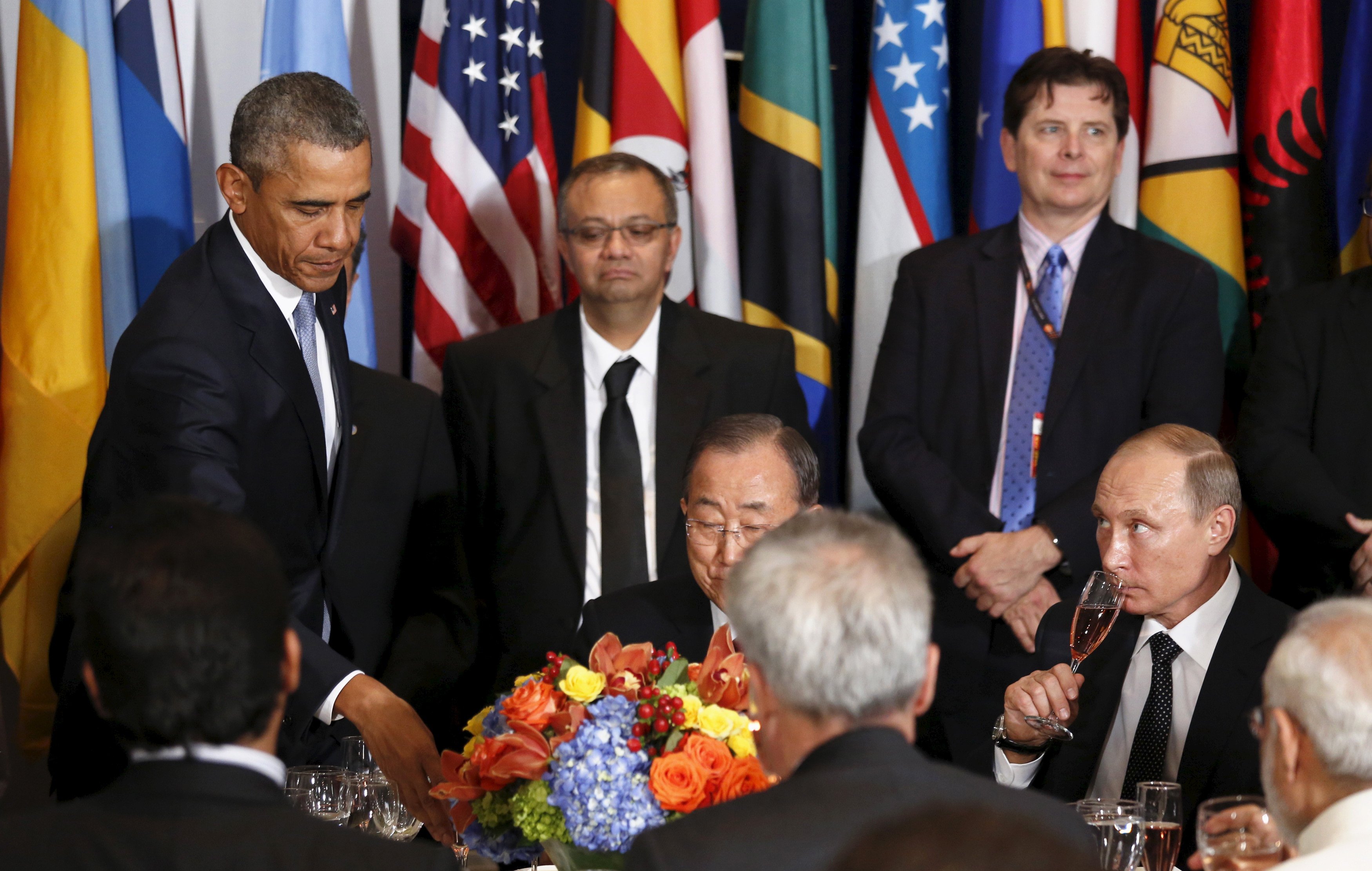
In an effort to increase its negotiating leverage during Syria peace talks in Vienna, the Obama administration has adopted a combined military and diplomatic approach that resembles a strategy employed last year to strong-arm Iran into negotiating with the West over its nuclear program.
In Syria, as in Iran, Washington is trying to pressure defiant parties into accepting the West’s terms by changing facts on the ground.
With Iran, it was economic sanctions, an increased military presence in the Persian Gulf, and a covert intelligence war. With Syria, it is a timeline for the departure of Syrian President Bashar al-Assad, the (perhaps symbolic) deployment of 50 special-operations forces to northeastern Syria to help local elements fight ISIS, and a covert CIA program to arm moderate Syrian rebels with antitank missiles.
In Iran, the US’s strategy of combining diplomatic and military pressure ultimately worked: A nuclear deal was finalized in July. But it worked because the US and its partners were largely united in their desire to eliminate the threat of a nuclear Iran.
As The New York Times’ David Sanger and Helene Cooper pointed out on Tuesday, "no such unanimity" exists in Syria, where the US faces two defiant and emboldened adversaries — Russia and Iran — and a regional ally, Saudi Arabia, which attended peace talks only grudgingly and is busy with its own air war over Yemen.
Frederic Hof, a former special adviser for transition in Syria under then US Secretary of State Hillary Clinton, told Business Insider in an email that the West’s best chance at creating negotiating leverage lies not in a combination of airstrikes and weak ground forces, but in protecting Syrian civilians from Assad’s atrocities.
"Washington should demand that Russia and Iran get their client out of the atrocity business before the Vienna meetings reconvene," said Hof, now a senior fellow at the Atlantic Council. "If they can’t or won’t do it, we should consider using cruise missiles against Assad regime targets who continue to create mass civilian casualty events."
 Reuters
Reuters
"The Western objective should be to make it somewhere between very hard and impossible for Assad to massacre lots of people," Hof added. "Assad’s atrocities — barrel bombs, gravity bombs, artillery and missiles directed against civilian residential neighborhoods — do three things: kill and stampede lots of people; create recruits for ISIS; and prevent any possibility of dialogue and negotiation between Syrians."
Indeed, the Assad regime’s use of barrel bombs — steel barrels packed with explosives and shrapnel — against its own citizens has allowed ISIS to market itself as the only group that can protect Syrians from the government’s brutality.
Moreover, Hof said, as long as ISIS — aka the Islamic State — continues to control large swaths of Syria, the US will have little success in pressuring Iran and Russia to accept a diplomatic solution to the conflict that does not include Assad.
"ISIS controls about half the country. It’s given Russia a pretext to intervene," Hof said.
 REUTERS/Allison Joyce
REUTERS/Allison Joyce
In its first week-plus of military action in Syria, roughly 90% of Russian airstrikes launched in Syria targeted rebel groups unaffiliated with ISIS. That was not an accident. Experts agree that Russia is eliminating moderate rebels on the ground so ISIS is able to gain more territory and become the "last man standing" in the battle against Assad.
"What Putin wants, and what Iran’s Supreme Leader supports, is a situation in Syria where only two significant figures — Assad and the so-called caliph of ISIS [Abu Bakr al-Baghdadi] — are left standing," Hof said in remarks to the American Committees on Foreign Relations in Boise, Idaho, on Monday. "This — or so they believe — would be Assad’s ticket back to polite society."
John Schindler, a former US intelligence analyst, echoed this sentiment in an interview last month with The Daily Beast.
"It’s clear that Russia’s strategy in Syria is to make the conflict binary by giving Syrians only two choices: Assad or ISIS," Schindler told Daily Beast senior editor Michael Weiss. "Attacks on the FSA [Free Syrian Army], while encouraging defections to the regime, are a key component of how Russia operationalizes its strategy for Syria."
 REUTERS/Stringer
REUTERS/Stringer
And it is a strategy that, ultimately, could easily derail any Western efforts to achieve lasting peace in Syria.
"While accommodating Russian and Iranian demands for Assad’s survival and potentially even a de facto partition of the country may seem like an attainable objective, this will only prolong and intensify the conflict and will almost certainly spark a jihadist mobilization the like of which the world has never seen," Brookings fellow Charles Lister wrote for the BBC.
The US will have limited negotiating leverage, then, as long as ISIS keeps giving Assad and his allies an excuse to continue the war. And any strategy the Obama administration adopts to try to hasten an end to the conflict, experts say, will be futile as long as Assad’s crimes — which, in turn, fuel ISIS’s propaganda efforts — are not addressed.
"To beat ISIS in Syria — which would tilt the battlefield in Iraq the right way — we need to round up regional combat forces and Western European combat support forces to work with us," Hof told Business Insider.
He added: "This will be a very heavy diplomatic lift. But it would create the mother of all protected zones for the Syrian opposition to establish decent governance and prepare for negotiations."



